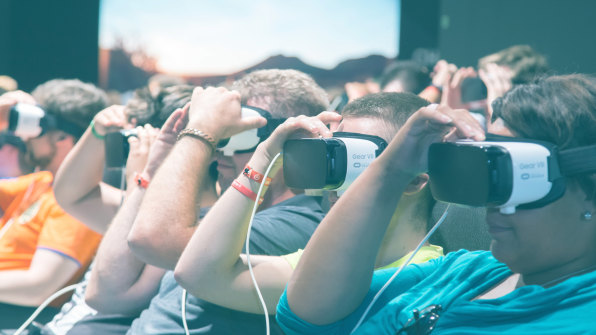As venture capital investing goes, so go startups and the technologies that those young companies develop. And so asking VCs about the investment areas they think will be hot once the calendar turns to 2018 can tell you a lot about the opportunities that will matter most in Silicon Valley and beyond.
For this roundup, we talked to investors at eight leading firms that invest in a wide range of tech-related areas. One thing that’s clear: 2018 doesn’t look like a year for breakout all-new technologies. Rather, the VCs told us that they’re most interested in maturing, relatively safe investment areas. Here are their thoughts on the most exciting areas likely to get their dollars this year.
HAYLEY BARNA, FIRST ROUND CAPITAL
The Human Side Of Algorithms
“There’s not a day or week that we don’t receive pitches with an AI component,” Barna says. “The thing we’re interested in at First Round is, what’s the flip side? What are the investment opportunities in human impact?…Not removing people from the equation, but giving people superpowers.” She points to personal-shopping service Stitch Fix, which uses AI to help stylists make more effective fashion suggestions for customers.
Community-Based Businesses
“It’s pretty clear that people are dealing with the effects of digital overload,” Barna says. “Too much screen time, and we’re feeling disconnected because of it. We’re thinking of businesses that counteract that.” One example: Coworking spaces targeting specific constituencies, such as women.
A Modern Take On Wellness
“Beyond just traditional medicine,” Barna explains. “More holistic, more on mental health, more on alternative practitioners, [like] acupuncture, or mind/body connections.”
Blending The Physical And Digital
“I don’t think the physical and digital are going to be so segregated. We see many pitches about ‘omnichannel.’ It was a buzzword for retail, but I think it applies to all areas…[digital companies] doing pop-up experiences, or offline businesses creating digital portals.”
M.G. SIEGLER, GV
Targeted Social Networks
“I think we’re seeing the natural movement toward people doing smaller, niche-focused networks again,” says Siegler, who has worked at Alphabet’s investing arm since it was known as Google Ventures. “This is more based around particular areas of interest….Maybe [it’s for] the younger generation, the generation below the core generation that came up on Facebook.”

Synchronous Interactions
The success of HQ Trivia, a game with shows scheduled for specific times, “harkens to olden days,” says Siegler. “When people were forced to listen to the same thing, or watch the same thing on TV, dating back to the game shows of the ’50s, when people gathered around, or even more recently to Who Wants To Be a Millionaire. It’s antithetical to the way social networks have been predominantly used, connecting people but doing so asynchronously. What if there’s a desire for people doing the same thing at the same time in a connected way?”
VAS NATARAJAN, ACCEL
E-sports
“What’s happened over the last 18-24 months, with the rise of Twitch, there’s a massive global core gaming audience, tens of millions of core to mid-core gamers,” says Natarajan. “That used to be the gaming market. In the past two to three years, suddenly that market multiplied. Now it’s not just the gamers, it’s the audience, people watching [the gamers].”
“New product and company opportunities are going to emerge from that,” he adds. “It used to be, Who are the content guys, the large studio publishers? That used to be our investment framework. Now it’s who are the founders building the connective services? …It’s amazing to think about core gaming as a spectator sport, and all the interesting new platforms and services that will support that.”
BENEDICT EVANS, ANDREESSEN HOROWITZ
Autonomy
Evans says that when the day comes that cars, buses, and other vehicles no longer need drivers, it’ll be possible to completely re-imagine what those vehicles can be, and—even better—re-imagine the world in which they move. “If you’re building public infrastructure or planning a city, then [long-term planning] absolutely needs to be something that figures into your thinking.”
Specialized Artificial Intelligence And Machine Learning
Machine-learning driven automation will lead to a wide range of new business opportunities, Evans says, including many companies focused on single-purpose implementations of AI and automation. As well, he says, automation will provide a massive multiplier effect by being able to do the small tasks that thousands of people could do–like look for patterns in images.

Mixed Reality
Clearly, there’s interest in this area, as expressed by the $1.9 billion invested in Magic Leap. But Evans is less inspired by the idea of augmenting our existing world–like digital recipes we can see when we’re at the stove–and more by wearable devices that can see and interpret, what’s going on around us. If such a computer could you who people in front of you are, when you last met them, and how they fit into your life or business, that would be exciting. So would it being able to tell you instantly if a product you’re holding at a store is available cheaper online.
Cryptocurrency
Bitcoin may get all the ink, but there are plenty of other cryptocurrencies, and more to come. Evans says that the way they enable distributed value storage without needing central authority is valuable at a time when people have lost faith in institutions and seek more control over money without governmental intrusion.
VIJAY PANDE, ANDREESSEN HOROWITZ
Computational Biomedicine
“You hear we’re looking for a cure to cancer, but there will never be a single medicine to cure cancer,” Pande says. “But we already have many drugs for cancer…The problem is people get them too late. You don’t wait until your house is half burned down before you call the fire department.”
The answer is technologies that can detect cancer much earlier than ever–at high accuracy and low cost–in a reproducible way. “My vision for cancer is it becomes very boring and routine, like going to the dentist,” Pande says.
New Bio-Utilities
If new technologies made fruits or vegetables last up to three times longer, Pande says, farmers could pick tomatoes at peak ripeness and they’d still taste great when they landed in a supermarket. “You could ship fruits and vegetables to new markets, or to the third world….It’s only possible due to this engineering approach,” he adds.
BOB KOCHER, VENROCK
Healthcare Delivery Optimization
In 2018, “I think concerns about disruptive change [related to healthcare] coming from Washington are going to be totally diminished, so people are going to be calmer in the delivery system.” Kocher says. “Health care providers will turn their attention to increasing profitability instead of bracing for large structural changes. And rather than raising prices, they’ll focud on efficiency.
Kocher says his firm will continue looking for digital health companies with novel ways to reduce costs and improve outcomes. “We continue to look at things that take economic responsibility for the cost and outcomes of care, and use technology and data to make both of those better and more efficient.”
Single-Cell DNA Sequencing
“In our body we have millions of normal cells and then we have the ones that aren’t normal,” Kocher says. “And if you don’t sequence the abnormal ones, you don’t know about the problems. So this notion of being able to do single cells versus just the average of when they break up all the cells in the blood, is an important nuance. That’s going to become an important clinical tool in the future. Today we’re just testing average DNA sequences, so you miss stuff.”

BRYAN ROBERTS, VENROCK
Genetics Technologies For Healthcare
“There is absolutely a trend over the next 5 to 10 more years toward more personalized, more data-based, more genetic-based, information being included in your interactions with your provider, whether on a generalized basis or in response to specific disease issues,” Roberts says. “Cancer is one that’s very prominent but there will be other ones that come along, and over time we’ll build up those disease-specific ones into a more holistic look at clinically relevant genetics for patients to talk to their doctors about.”
He adds that “the long pole in that tent is actually going to be discoveries in biology to allow us to make those associations [between genetic markers and reactions in the body] well. The puck is not going to be on the DNA sequencing or genetic side of things, it’s going to be ‘OK, what do I do with this knowledge?”
KARL HANDELSMAN, ROCHE VENTURE FUND
Synthetic Biology In Consumer Products
“One of the unsung heroes of synthetic biology is detergents for washing clothes, which now work well at all different temperatures,” Handelsman says. “You can now use very hot water and still get bright whites. That’s because of all the amazing enzymes that have been evolved and engineered. People are also talking about changing photosynthetic pathways in rice. So the rice loses its resistance to cold but it gains 20% in metabolic efficiency. Given global warming, that might be a good trade-off.”
PAUL BERNARD, AMAZON ALEXA FUND
Ambient Voice In New Places
Bernard, who invests Amazon’s own money in startups that leverage the Alexa and Echo ecosystem, says that “while voice services started in the home and will continue to grow there, we’re beginning to see this technology move beyond the home and into new on-the-go environments–in the car, the enterprise, in the gym or on a run, and numerous other mobile scenarios. We see this is a key factor that will make interacting with voice services a truly pervasive daily habit, and we expect to see different device concepts emerge that address the unique requirements of each usage scenario.”

BRENDAN WALLACE, FIFTH WALL VENTURES
Energy Efficiency Software
Software to conserve energy usage is “inherently a real estate technology for no other reason than that real estate consumes two-thirds of the U.S. electricity market,” says Wallace, whose firm focuses on investments in startups that tackle “built world” opportunities. “When you think about saving electricity, the most obvious place to look is buildings.”
Real Estate As A Service
With real estate at 14% of U.S. gross domestic product, there will be lots of capital raised for things like on-demand self-storage, coworking, and coliving concepts, Wallace believes.
Operating Systems And Analytics For Buildings
“As there’s more data available from sensors in buildings, they will provide analytics that could ‘say, turn off your HVAC 20 minutes earlier,’ and that could be a huge savings. Anything that moves in a building, a hinge, an elevator, a desk, will have a sensor in it…No joke, it’s a trillion-dollar capital opportunity.”
Real Estate Drones
“Some of the most promising applications of drones, [though] pretty pedestrian from the innovation standpoint [are things] like checking roof leaks,” Wallace says. “It’s very easy to use infrared technology to detect soft points in roofs. That is going to be one of the biggest single markets for drones. Landlords are looking for drone solutions.”

Recent Comments